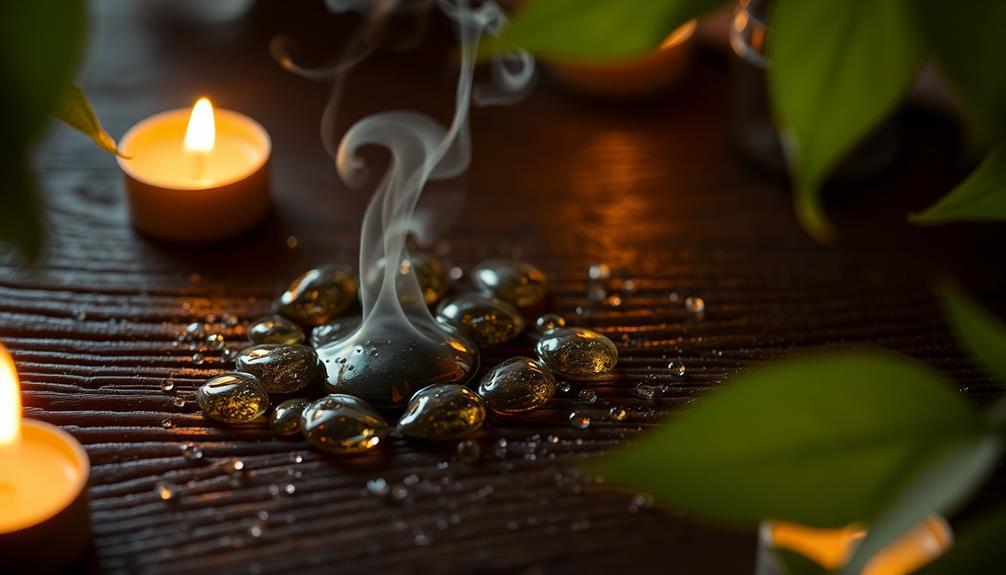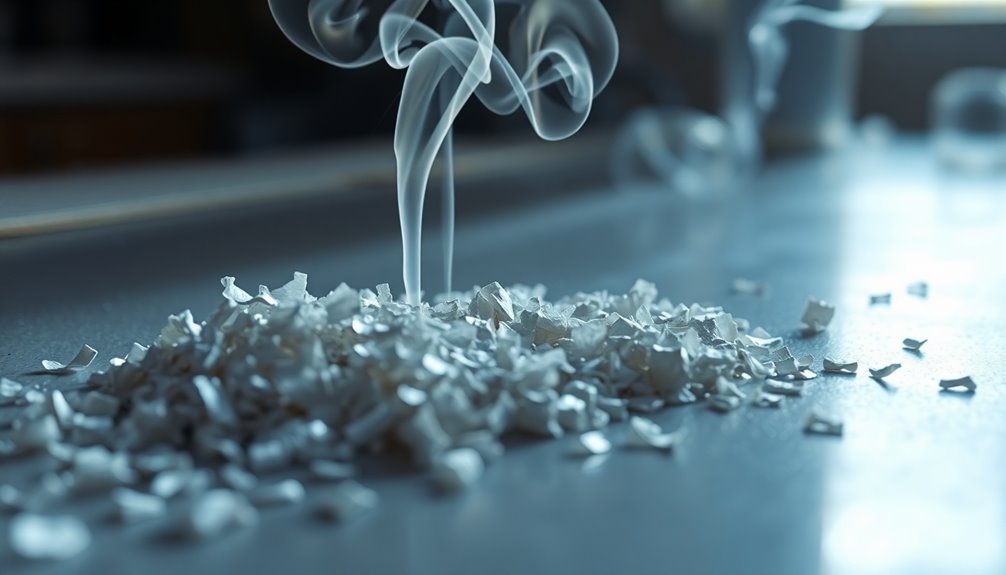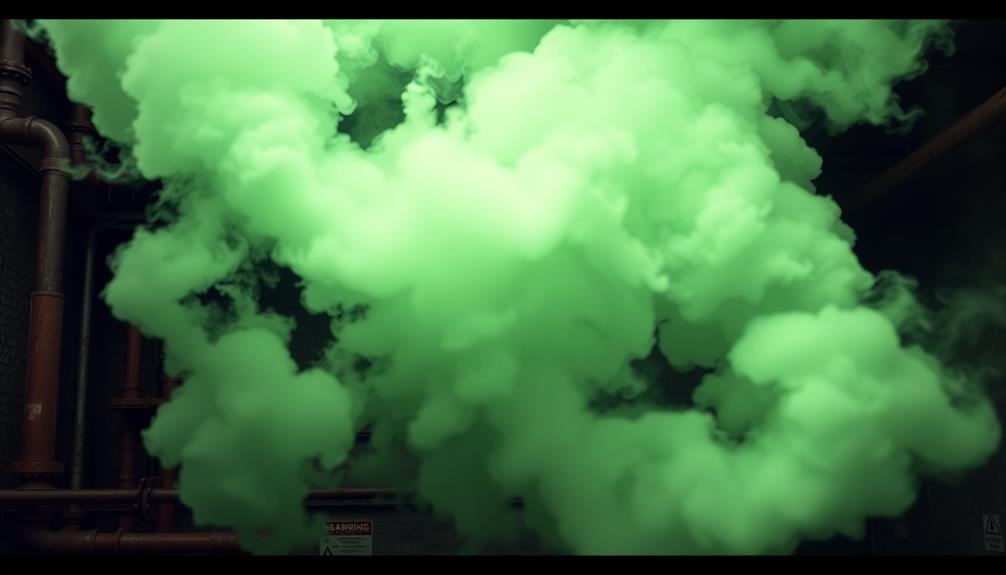Frankincense smells like a warm, woody hug with a twist! Imagine a cozy mix of earthy scents, mixed with bright citrus and a hint of spice. It's like the smell of a peaceful forest with notes of musty pine and peppery, smoky undertones. Fresh oils bring a lively zing, while older resins have a deeper, richer scent, reminding you of ancient cathedrals. People often use it in calming spaces, like yoga studios or during holidays. It creates a lovely atmosphere, especially for relaxation or meditation. Stick around, and you'll uncover even more exciting details about this special scent!
Key Takeaways
- Frankincense has a woody aroma with citrusy and spicy undertones, creating a calming and spiritual scent experience.
- The fragrance features musty pine and peppery, smoky notes, contributing to a cozy atmosphere.
- Fresh essential oils are vibrant, while older resins evoke richer, more complex scents reminiscent of ancient churches.
- It is sweeter and warmer than myrrh, which has a more bitter profile, enhancing its appeal in aromatherapy.
- Frankincense is often used in spiritual settings, wellness retreats, and home ambiance, promoting relaxation and emotional well-being.
Introduction
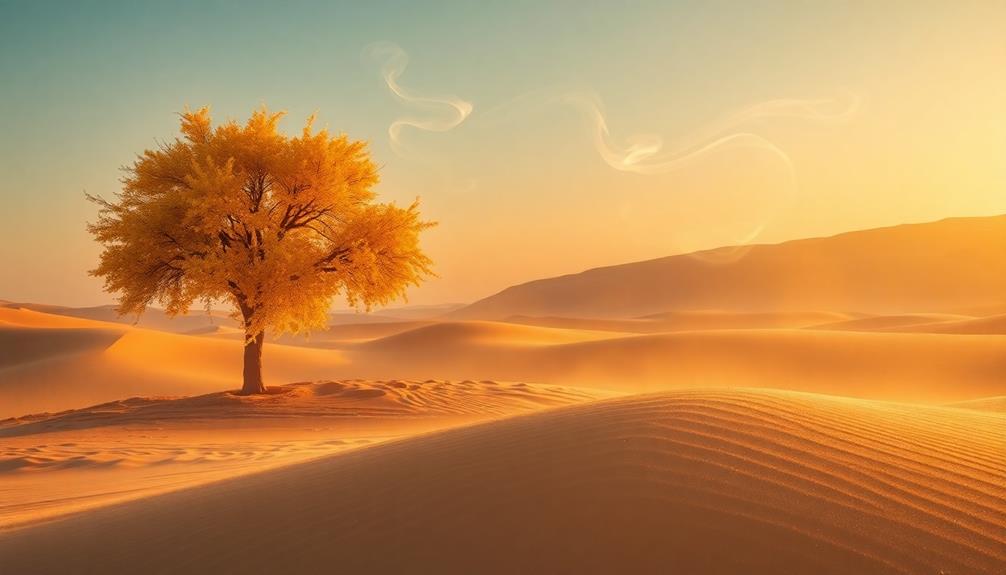
Frankincense, often revered for its aromatic qualities, captivates the senses with its unique blend of woody and earthy notes. You might notice that this special resin comes from the Boswellia tree, which grows in warm climates.
The aroma of frankincense isn't just any scent; it has a calming and spiritual aroma that many people find comforting. Imagine walking into a peaceful space filled with its warm, sweet fragrance.
Frankincense has a delightful woody scent that can also carry citrusy and spicy undertones. This makes it stand out from other resins, like myrrh, which tends to be more bitter and earthy.
Fresh frankincense has a lighter fragrance, while older resins offer richer, more complex scents, similar to those found in ancient churches.
You'll discover how variations in scent can depend on the type of Boswellia tree, the soil it grows in, and even the weather. Each of these factors brings a new twist to the aroma, making frankincense an exciting and diverse experience.
Description of the Smell
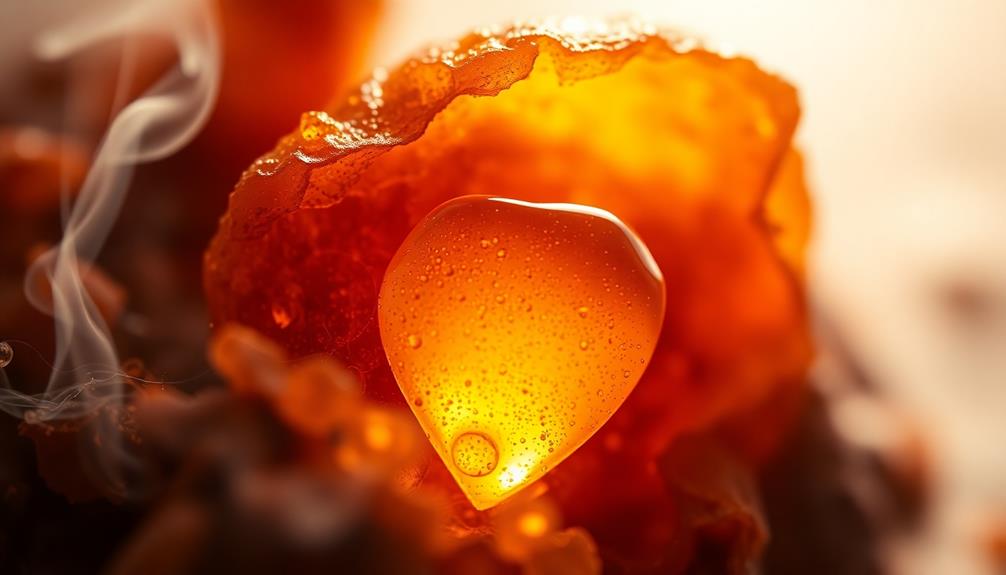
The smell of frankincense envelops you in a warm embrace, instantly transporting you to serene spaces filled with tranquility. This delightful frankincense scent belongs to the amber fragrance family, showcasing a woody aroma that feels both earthy and spiritual.
When you take a deep breath, you might notice hints of musty pine and a peppery, smoky undertone that makes you feel cozy and calm. Fresh frankincense essential oils have a lighter, vibrant fragrance, while older resins offer a richer scent reminiscent of ancient churches.
You'll find that frankincense is sweeter and warmer compared to myrrh, which tends to be more bitter. This warm, inviting scent is often used in traditional medicine for its health benefits, helping to soothe both body and mind.
As the aroma surrounds you, it evokes memories of sacred spaces where people gather to meditate and find peace. With its complex notes and uplifting qualities, frankincense creates an atmosphere of harmony, making each moment feel a little more special.
Whether you're using it in rituals or simply enjoying its beauty, frankincense truly brings a sense of joy and wellness to your life.
Source and Composition

Derived from the resin of the Boswellia tree, frankincense is a unique gift of nature that thrives in arid regions like Oman, Yemen, and Somalia. This incredible tree looks a bit like a desert bonsai, and it produces a special sap. To collect the resin, workers make small cuts in the bark, letting the sap ooze out and harden. You'll find this resin in beautiful, semi-translucent chunks that can be white to golden-amber in color.
The source of frankincense matters! Different species of Boswellia, along with where they're grown and how the resin is harvested, affect its quality.
When you smell frankincense, you'll notice a mix of woody and earthy scents. The essential oil contains volatile compounds like alpha-pinene, limonene, and myrcene. These compounds create that distinctive aroma you might recognize.
Each type of frankincense can smell a bit different because of the tree type, the soil it grows in, and the climate.
Typical Scenarios or Environments
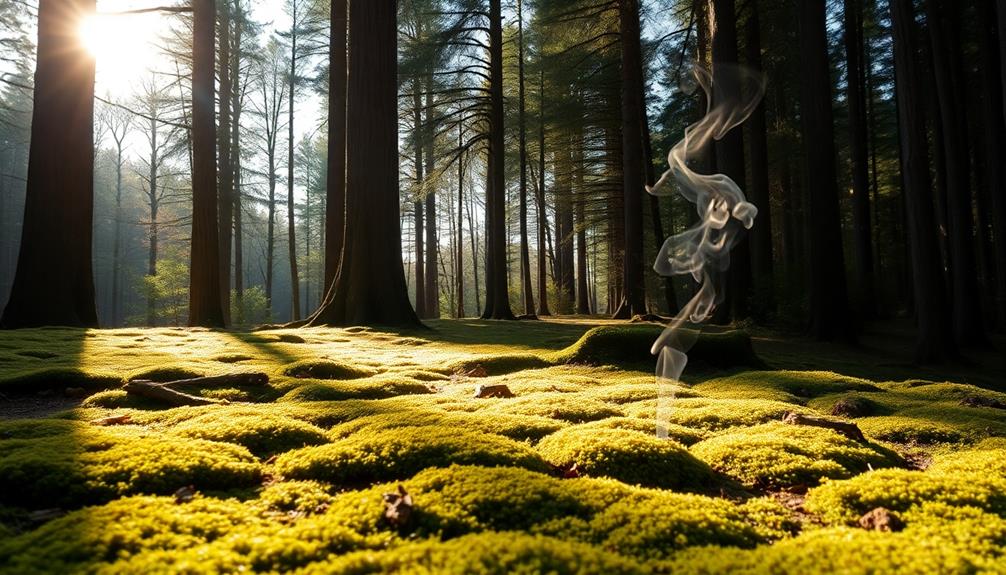
In many spiritual and wellness settings, the aroma of frankincense plays a pivotal role in enhancing the atmosphere. Imagine walking into a church or temple, where the warm, resinous scent of frankincense fills the air. It's often used as incense during services, creating a special feeling that makes you want to reflect and meditate.
In your own home, especially during the holidays, you might light frankincense candles or burn incense sticks. The aromatic and earthy scent invites everyone in, creating a cozy and calming space for gatherings and celebrations.
You'll also find frankincense in wellness retreats and spas, where its benefits are truly appreciated. It's often diffused or mixed into massage oils to relieve stress and promote relaxation. The sweet, warm fragrance transforms the room, making it perfect for unwinding after a long day.
With its luxurious scent, frankincense is a fantastic choice for home fragrances, bringing a touch of the divine into everyday life.
Emotional or Cultural Associations
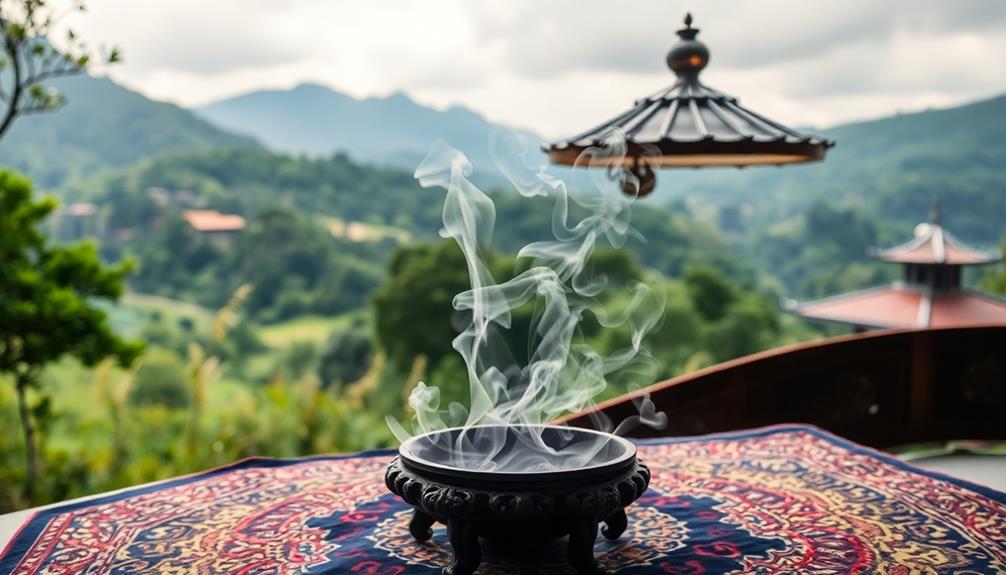
Many people associate frankincense with deep emotional and cultural significance, as its scent has been woven into spiritual practices for centuries. When you take a deep breath of frankincense, you might feel a wave of calm wash over you. This special incense has been used in many religions, like Christianity, Judaism, and Islam, to make spiritual moments even more meaningful.
The warm, woody, and earthy notes create a grounding experience that helps you feel connected to something greater.
Frankincense isn't just about spirituality; it also promotes emotional well-being. Many folks use it during meditation or mindfulness exercises to help reduce stress and foster a sense of peace. The soothing aroma encourages introspection, allowing you to explore your thoughts and feelings in a comforting way.
In various cultures, frankincense has been linked to healing and protection. It's often used in rituals designed to promote both physical and spiritual health.
Health or Safety Considerations
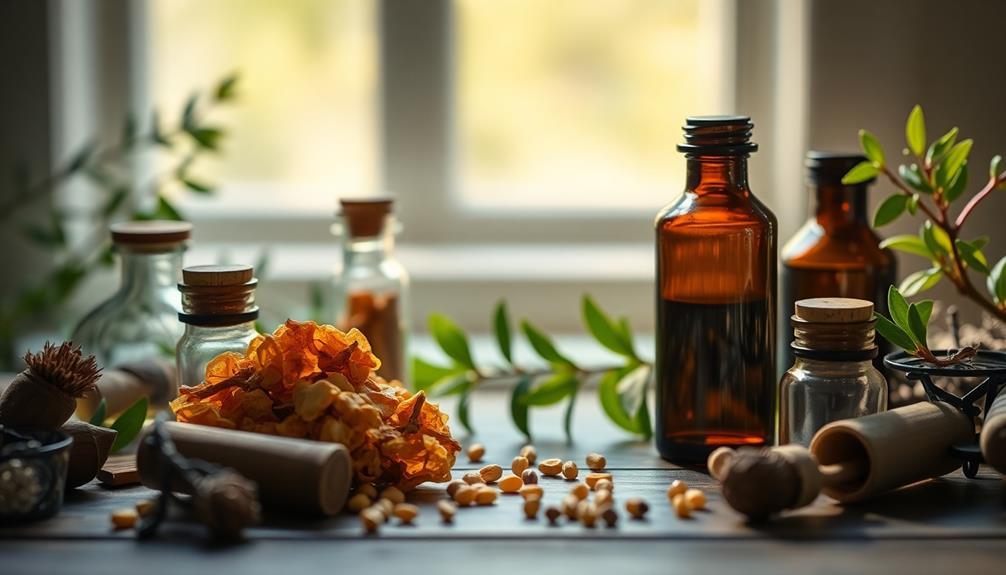
When using frankincense, it's crucial to consider safety and health precautions to ensure a positive experience. This wonderful oil is often used in aromatherapy, but it can cause some skin irritation if applied directly. To keep your skin happy, always dilute frankincense essential oil with a carrier oil before using it on your skin.
If you're pregnant or breastfeeding, it's best to consult a healthcare professional before trying frankincense, as we don't know everything about its effects during these important times.
Also, if you take medications, be careful! Frankincense may interact with certain medications, especially those that affect blood pressure or blood sugar levels.
Lastly, while frankincense can be delightful, remember that too much of a good thing can be bad. Ingesting excessive amounts can lead to tummy troubles, so always follow recommended guidelines for use.
Final Thoughts
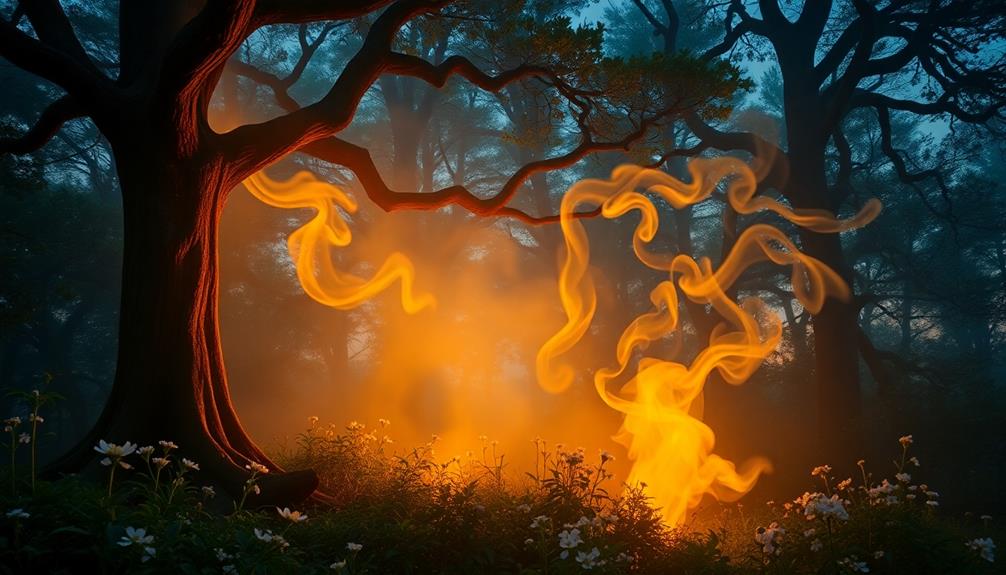
Wrapping up our exploration of frankincense, it's clear that this remarkable oil offers a unique and multifaceted scent experience.
The smell of frankincense is truly special, combining woody, earthy, and resinous notes that ground you and make you feel connected to nature. When you take a deep breath, you might notice sweet, honey-like undertones mixed with citrusy and spicy hints, kind of like the warm atmosphere in ancient churches filled with burning incense. The scent profile of bergamot can complement the deep richness of frankincense with its bright and uplifting citrus notes, adding a refreshing balance to the aroma. Together, the two evoke a harmonious blend of warmth and light, creating a sense of tranquility and clarity. As the fragrances mingle, they transport you to serene, meditative spaces where your mind feels both energized and at peace.
You might find that older resins create richer and more complex scents, while fresh essential oils of frankincense have a lighter and more vibrant fragrance.
If you prefer something thicker, resinoids will give you a more intense aroma. No matter what form you choose, frankincense can evoke feelings of warmth and spirituality, making it a favorite for both perfumery and aromatherapy.
Frequently Asked Questions
How Do You Describe the Smell of Frankincense?
When you describe the smell of frankincense, you notice its warm, woody tones blending with sweet hints and earthy nuances. Its rich aroma evolves, offering a grounding yet uplifting experience that captivates your senses.
Does Frankincense Oil Smell Like Tea Tree Oil?
No, frankincense oil doesn't smell like tea tree oil. While frankincense has a warm, woody aroma, tea tree oil offers a fresh, medicinal scent. Each oil brings its unique qualities to aromatherapy and wellness practices.
Why Is Frankincense so Special?
You'll find frankincense special because it's rich in history and spirituality. Its unique properties promote relaxation and emotional well-being, making it a valued component in meditation and aromatherapy practices across many cultures and traditions.
What Scent Compliments Frankincense?
To complement frankincense, try mixing it with cypress oil for a piney touch or rosemary for a richer aroma. You can also experiment with myrrh or copal resin to enhance the scent's depth and complexity.
